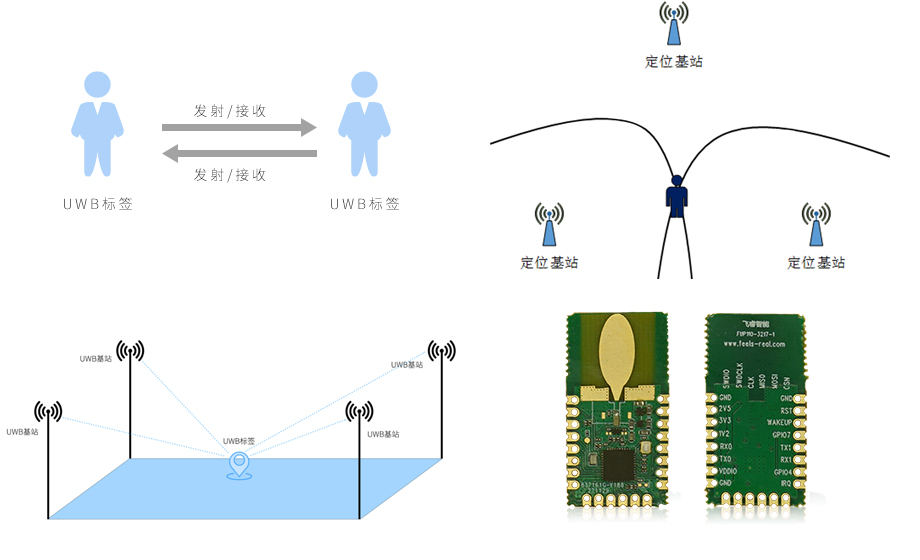With the wide promotion of the Internet of Things, various emerging positioning technologies have attracted more and more attention. As a new positioning technology, UWB technology has become a hot topic in the field of Internet of Things. However, many people are not clear about the difference between UWB tag and UWB base station, and even think they are the same thing. This article will introduce the differences and connections between UWB labels and UWB base stations in depth.

I. Definition of UWB label and UWB base station
UWB tag and UWB base station are both important components of UWB positioning technology. The difference between them is that each plays a different role in the positioning system.
1. UWB label
A UWB tag is a wearable, scanning or positioning tag that is the located part of the UWB positioning system. Its main function is to be used for precise positioning and information transmission in the positioning system.
2. UWB base Station
The UWB base station, also known as the UWB anchor point or infrastructure node, is the leading part of the UWB positioning system. Its main function is to act as the central node in the positioning system, collect and process the signal information sent by the UWB tag, and convert it into the physical location of the tag.
Two, UWB label and UWB base station working principle
1. Working principle of the UWB label
UWB tags work by transmitting very short RF pulses to communicate. When it emits an RF pulse, the UWB base station emits its own RF pulse. When the UWB tag receives an RF pulse from the UWB base station, it records the arrival time of its RF pulse and then passes this information back to the UWB base station. The distance and coordinates from each label to the base station are calculated through the UWB base station, so as to achieve accurate positioning.
2. Working principle of UWB base station
The communication between the UWB base station and the UWB label is two-way. When the UWB base station emits an RF pulse, the UWB tag records the arrival time of the pulse and sends the record back to the UWB base station. This timestamp information is used to calculate the distance between the UWB tag and the UWB base station and convert it to the physical location of the tag.
Iii. Differences between UWB labels and UWB base stations
Although UWB tags and UWB base stations work in a similar way, there are some important differences.
1. Positioning accuracy
UWB tags generally have higher positioning accuracy than UWB base stations. This is because during transmission, the UWB tag can directly measure the timestamp of the RF signal, thus calculating the distance and position of the tag to the base station. The positioning accuracy of UWB base station depends on the accuracy of the collected label information and the corresponding algorithm.
2. Different functions
The main functions of the UWB tag are precise location and data transmission, while the UWB base station receives and processes the RF signals from the tag, and calculates the physical position of the tag. Therefore, they have different roles in the UWB positioning system.
3. The application scenario is different
Due to its high precision positioning accuracy and real-time performance, UWB tags are usually more suitable for those scenes with high precision requirements, such as non-implicated vehicle positioning, transportation and logistics, indoor navigation and other fields. UWB base stations are more suitable for large-scale deployment of the UWB positioning system. For example, the area involved in the system is relatively fixed, and multiple base stations are required for positioning.
Iv. Connection between UWB label and UWB base station
Although there are some obvious differences between the UWB tag and the UWB base station, they are also very closely related in the UWB location system.
In the UWB positioning system, the UWB tag and the UWB base station are closely coordinated. The UWB tag transmits the location information, and the UWB base station receives and calculates the location information. Therefore, their close cooperation, complement each other's functions, in order to achieve a high precision UWB positioning system.
5. How to apply UWB label and UWB base Station
Since both UWB tags and UWB base stations play an indispensable role in the UWB positioning system, they can be applied in many fields, such as:
1. Logistics industry
UWB tags and UWB base stations can be used to track and monitor the transportation and logistics of goods. Their high-precision positioning and real-time performance can greatly improve the efficiency and manageability of logistics.
2. Indoor navigation and positioning
UWB tags and UWB base stations can be used for indoor navigation and positioning. These systems can help people find destinations quickly in complex indoor environments.
3. Industrial manufacturing and safety monitoring
UWB tags and UWB base stations can be used for industrial manufacturing and security monitoring. Through the comprehensive monitoring of UWB positioning system, the operation management and safety control of the factory can be realized, and the production efficiency can be improved.
4. Other areas
UWB label and UWB base station can also be used in smart home, smart city, security monitoring and other fields, so as to achieve a safer, more convenient, more efficient lifestyle.
summarize
This paper mainly introduces the working principle, difference and relation of UWB label and UWB base station. Although the UWB tag and UWB base station play different roles in the positioning system, they can cooperate to achieve a high-precision, real-time and reliable UWB positioning system. The convenience and benefits brought by UWB label and UWB base station make them become an important part of the universal Internet of Things, and will be more and more widely used in the future Internet of Things construction process.



